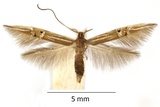Cosmopterix lienigiella Zeller, 1846 Species
Last modified: Dec. 5, 2025, 6:08 p.m.
A very rare and local species in Belgium, only known from some dispersed localities in Flanders.
Details
- Classification
- Family: Cosmopterigidae > Subfamily: Cosmopteriginae > Genus: Cosmopterix > Species: Cosmopterix lienigiella
- Vernacular names
- Gele rietprachtmot (NL), Lienigs Schilf-Prachtfalter, Gelber Schilf-Prachtfalter (DE)
- First mention in Belgium
- Van Daele E. & Pelerents C. 1969. Synthèse des observations effectuées pendant quatre années sur les lépidoptères nocturnes de la région horticole gantoise. — Mededelingen Rijksfaculteit Landbouwwetenschappen Gent 34: 31–56. On page 38.
- Status
-
Native
Distribution
Mine
At first a rather short, straight gallery, soon widening into an elongated blotch. Unlike the other Cosmopterix species which mine into Phragmites it does not construct a silken tube for shelter and hence, the larva is visible through the mine. Several larvae sometimes mine the same leaf.
See also bladmineerders.be
The mine and caterpillar of Cosmopterix lienigiella differ from those of Cosmopterix scribaiella in the following points:
- the lower part of the mine contains a collection of feces and does not end in a narrow passage
- the caterpillar has darker segmental incisions which gives it a pattern with transverse bands
- since the caterpillar does not produce a pupal web, both the caterpillar and the pupa are sometimes quite clearly visible in transmitted light
- pupation occurs at the upper end of the mine pointing towards the tip of the leaf
- the pupa lies upside down in the mine
Bionomics
The species hibernates in the larval stage, inside the mine.
Pupation in the mine in springtime.
The adults fly around the food plant at dusk and later come to light.
Flight periods
One generation a year from the end of May till mid-October.
Observed on
- Host plant (species):
- Phragmites australis
Monophagous on Phragmites australis.
Habitat
Most types of habitat where the foodplant grows, with a preference for large reed beds in both fresh and brackish water.







